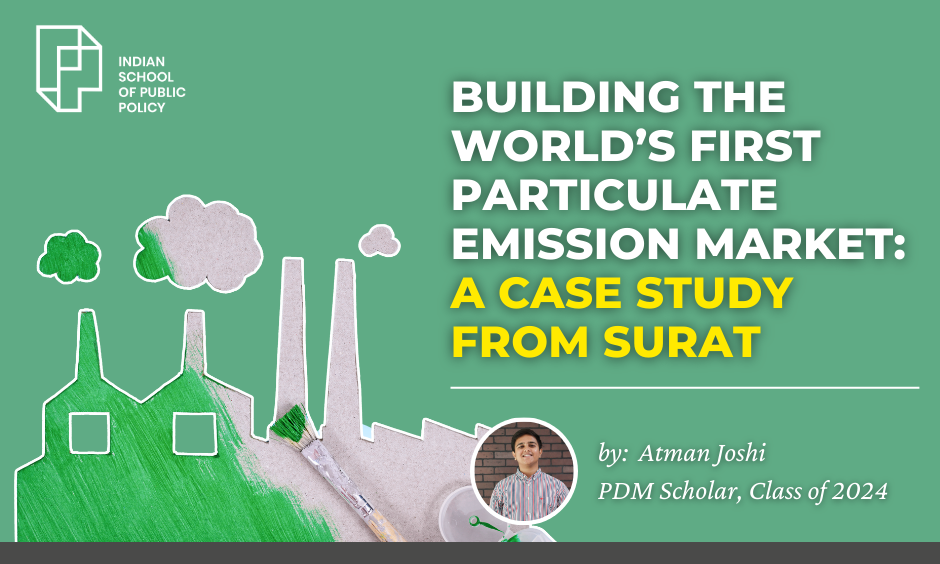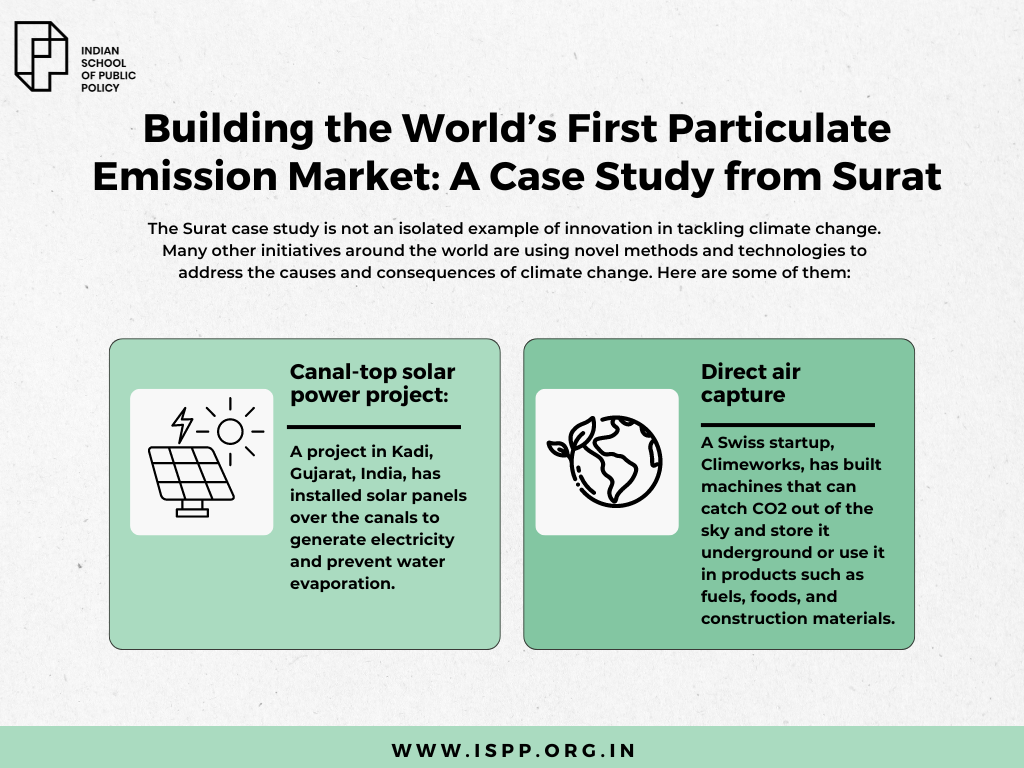
Building the World’s First Particulate Emission Market: A Case Study from Surat

Climate change is one of the most pressing challenges of the 21st century that requires urgent and collective action from all sectors of society. While governments and international organisations play a key role in setting the policies and frameworks to reduce greenhouse gas emissions and adapt to the impacts of climate change, there is also a need for innovative solutions from the private sector, civil society, academia, and individuals. In this article, we will explore one of such creative and effective ways of tackling climate change, starting with a case study from Surat, India.
Surat is a city in the western Indian state of Gujarat, known for its textile and diamond industries. It is also home to many chemical companies, paper mills and pharmaceuticals which emit a lot of Particulate Matter (PM). Particulate matter or PM is one of the major air pollutants. It is a mixture of solid particles and liquid droplets suspended in the air. PM comprises various substances, such as dust, pollen, soot, smoke, and chemicals. It can also vary in size, shape, and composition, depending on the source and the atmospheric conditions. Particulate Matters are categorized based on there diameter, e.g. PM10, PM 2.5, etc. In addition, they cause serious harm to human health and the environment. PM can penetrate deep into the lungs and even the bloodstream, which can cause respiratory and cardiovascular diseases, cancer, and premature death. Not only that, PM reduces visibility on the road leading to accidents.
To tackle this problem, researchers from the Energy Policy Institute at the University of Chicago (EPIC) collaborated with the Gujarat Pollution Control Board (GPCB) to design and implement a new market for PM emissions from industrial plants in Surat. The market, introduced in a randomized control trial, aimed to reduce air pollution while keeping the abatement costs low for the plants.
The market works as follows: each plant is assigned a baseline emission level on the total amount of particulate matter emissions that industries can emit in a given period. The cap is based on the data from the continuous emissions monitoring system (CEMS) installed in each industrial unit. The industries can comply with the cap either by installing technology that reduces pollution or by buying emission permits from other industries that have surplus permits. The permits are traded in a weekly auction, where the supply and demand of the permits determine the price. The plants have an incentive to reduce their emissions, as they can either save money by selling their permits or avoid paying for buying them. The GPCB monitors the emissions of the plants using CEMS and imposes strict penalties for non-compliance.
The researchers evaluated the impact of the market by comparing the plants that were randomly selected to participate in the market with those that were not. They found that the market reduced PM emissions by 20-30% relative to the control group, with no significant increase in abatement capital costs. The market also lowered variable abatement costs, as estimated from permit bids. In addition, the market achieved high compliance rates, as the plants faced credible enforcement of penalties.
The study by EPIC is the first to demonstrate the feasibility and effectiveness of an emission market in a developing country context. It also shows how CEMS can be used to measure and verify emissions in real time, and how penalties can be enforced to ensure compliance. The study has important implications for the design of environmental policies in India and other developing countries, where air pollution is a major challenge for public health and economic development.
The researchers hope that the market can be scaled up to cover more plants and pollutants in Surat and other cities in Gujarat. They also hope that the market can serve as a model for other states and countries that are interested in adopting market-based approaches to reduce air pollution. By creating a market for PM emissions, the researchers have shown how economic incentives can be aligned with environmental goals, and how innovation can lead to cleaner air and healthier lives.
The Surat case study is not an isolated example of innovation in tackling climate change. Many other initiatives around the world are using novel methods and technologies to address the causes and consequences of climate change. Here are some of them:
- Canal-top solar power project: A project in Kadi, Gujarat, India, has installed solar panels over the canals to generate electricity and prevent water evaporation.
- Direct air capture: A Swiss startup, Climeworks, has built machines that can catch CO2 out of the sky and store it underground or use it in products such as fuels, foods, and construction materials.
These are just some of the examples of the innovative solutions that are being developed and implemented to tackle climate change. They show that there is no shortage of creativity and ingenuity in finding ways to reduce emissions, enhance resilience, and create a more sustainable future. They also show that innovation is not limited to any sector, region, or scale. Anyone can be an innovator and contribute to the fight against climate change.
I hope that this article has informed and educated you about some of the innovative solutions to tackle climate change, and inspired you to take an interest in policy innovations. If you want to learn more about these and other solutions, you can visit the links attached to this article.
Infographic:

References:
1. https://www.dezeen.com/2021/06/14/carbon-climeworks-mining-sky-interview/
2.https://indianexpress.com/article/cities/ahmedabad/countrys-biggest-canal-top-solar-power-plant-ready-for-operations/

Atman Joshi
PDM Scholar, Class of 2024
Atman is a graduate from Rajkot, Gujarat. Nothing excites him more than telling stories. Casual conversations about philosophy, politics, spirituality and various forms of expressive arts, such as movies, music, and photography, are what he finds the most intriguing. Coming from a Gujarati family, he grew up with politics and business as the centre of his dinner table conversations and family gatherings.
This sparked his curiosity in social sciences at an early age. Through the course of time, he has developed a deeper interest in the field of public administration and public policy, which has led him to the Indian School of Public Policy, where he hopes to equip himself with the necessary skills and tools to become a better policy maker.
LinkedIn: https://www.linkedin.com/in/atman-joshi-08b907195/


